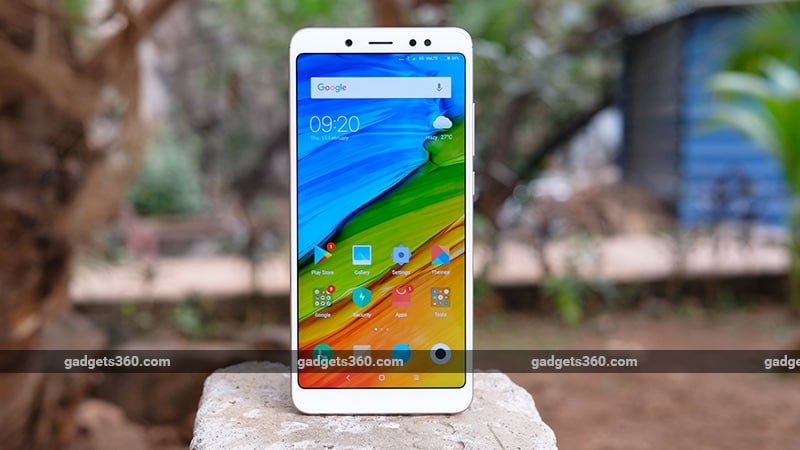- Home
- Mobiles
- Mobiles Features
- The Most Popular Phones of 2018
The Most Popular Phones of 2018

Xiaomi dominates the list of most popular phones of 2018
As India's biggest technology news and reviews destination, we are privy to tech trends before they hit mainstream. While Jio and other telecom-related stories continued to grab mindshare, the smartphone market in India saw Xiaomi consolidate its stronghold. The "notch" went mainstream, while towards the second half of the year we saw players like Realme and Asus take over from the likes of Oppo and Vivo, which struggled to sustain their earlier momentum.
Here are the top 10 phones that you searched for the most on Gadgets 360, a list that reflects some of the aforementioned trends. Since the list is based on total searches throughout 2018, it's understandably skewed towards phones that released earlier in the year.
The most popular phones of 2018
#10 - Jio Phone 2
Jio revolutionised the Indian telecom industry with its disruptive plans and extensive VoLTE network. With the Jio Phone, the company tried to bring 4G VoLTE to the masses and its successor improves upon the same with a full-sized QWERTY keyboard, a larger display, and a wider form factor.
The biggest USP of the Jio Phone 2 and one of the reasons for its popularity is the fact that it can run popular applications like WhatsApp, Facebook, and YouTube. The ‘smart' feature phone is priced at Rs. 2,999 and is available via Jio.com and other Jio authorised offline outlets.
#9 - Oppo F7
The Oppo F7 (Review) is another selfie-centric smartphone that makes this list. The selfie camera is easily one of the best in this phone's price range and software features like Sense HDR mode and AI Beauty mode are more than just gimmicks and actually work well. The smartphone also has a capable chipset, good battery life, and a vivid display.
We were not too impressed with the all-plastic body as well as the clunky and bloated user interface in our review. The Oppo F7 is offered in two variants — one with 4GB of RAM and 64GB storage and one with 6GB of RAM and 128GB of storage, both of which can be now found online for less than Rs. 20,000 and Rs. 24,000 respectively.
#8 - Realme 1
Oppo launched the Realme sub-brand with an aim to take on Xiaomi in the budget smartphone market. The first smartphone from Realme, which has now become an independent company, made a significant impact on the market thanks to its unique fibreglass design, powerful performance, and solid battery life. We were unimpressed with the Realme 1's cameras and cluttered OS but the value for money on offer more than made up for those drawbacks.
The Realme 1 (Review) was launched with a lucrative price tag of Rs. 8,990 for the 3GB RAM/32GB storage variant. Sadly, Realme has discontinued the 3GB variant in order to make space for the Realme 2 (Review) in their-line up, making the base model the one with 4GB of RAM (Rs. 10,990).
#7 - Asus ZenFone Max Pro M1
The ZenFone Max Pro M1 revived Asus's fortunes in India and its disruptive price tag sent ripples amongst the smartphone industry. The smartphone, which received a stellar 9 rating in our official review, ticks almost all the right boxes with a large 4,000mAh battery, a near stock build of Android, a bright and vivid 5.99-inch fullHD+ display, and great performance courtesy the Snapdragon 636 chipset.
While we were unimpressed by the battery life initially, a few software updates have taken care of that criticism. There are multiple variants of the smartphone on offer with the 6GB RAM variant sporting enhanced cameras. Priced at Rs. 10,999, the base variant with 3GB of RAM and 32GB of storage offers the best bang for the buck.
#6 - Xiaomi Mi A2
The Xiaomi Mi A2 (Review) was launched in August 2018 and served as a successor to the popular Mi A1 (Review), which was the first Android One smartphone from Xiaomi. With the powerful Snapdragon 660 processor under the hood and a clean software package devoid of bloat, the Xiaomi Mi A2 offers top-notch performance. The display is crisp and vivid and the cameras are amongst the best in this price range.
If you can make peace with the lack of a 3.5mm headphone jack and microSD slot, the base variant of the Xiaomi Mi A2 with 4GB of RAM and 64GB of storage makes for a great buy. This variant also got its price slashed recently from Rs. 16,999 to Rs. 15,999, making it an even better deal.
#5 - Vivo V9
As the first Android smartphone with a notch in India, the Vivo V9 (Review) paved the way for the notched landscape we find ourselves in today. The smartphone lacks a USB Type-C port and the battery life as well as low-light camera performance are underwhelming. That said, the software is feature-packed, performance is above average courtesy the Qualcomm Snapdragon 626 SoC and the design is eye-catching, if a bit derivative. There are better options in the market right now but the Vivo V9 made for a good buy in its prime.
#4 - Xiaomi Redmi Note 5
Xiaomi has been quite aggressive this year and the Redmi Note 5 (Review) was amongst the first phones it launched in 2018. A solid well-rounded device, the Redmi Note 5 impressed us with its build quality, stellar battery life, and above average camera quality. MIUI's bloatware has been a constant source of complaint and was the Achilles heel of this smartphone as well.
The smartphone has now been replaced with the Redmi 6 Pro (Review) in Xiaomi's line-up with a Redmi Note 6 conspicuous by its absence.
#3 - Xiaomi Redmi Y2
One of five Xiaomi smartphones on this list, the Redmi Y2, is built for selfie aficionados. In our official review, we were impressed with the AI-enabled 16-megapixel selfie camera, which delivered good shots in various lighting conditions. The dedicated microSD card slot and good battery life help round up the package.
There are more well-rounded phones like the ZenFone Max Pro M1 (Review) and Realme 1 (Review) in this price range but the Redmi Y2 is the best option for those who value selfies over everything else.
#2 - Xiaomi Redmi 6 Pro
The first Redmi phone outside the Redmi Note series to sport the ‘Pro' moniker, the Redmi 6 Pro (Review) offers very good battery life, great build quality, a dedicated microSD slot, and a bright and vivid display. It is offered in two variants — one with 3GB of RAM and 32GB of storage priced at Rs. 10,999 and one with 4GB of RAM and 64GB of storage that carries a price tag of Rs. 12,999.
The Redmi 6 Pro is also the cheapest Xiaomi smartphone with a notch, a "feature" that seems to be in demand these days. However, the phone does not really make a strong case for itself in Xiaomi's line-up, with the Redmi Note 5 Pro (Review) and Redmi Y2 (Review) offering more value for money.
#1 - Xiaomi Redmi Note 5 Pro
It's no surprise that the Xiaomi Redmi Note 5 Pro was the most searched-for smartphone of the year. The Redmi Note 5 Pro is a solid all-rounder with competent dual cameras, great build quality, a sleek all-metal design, and impressive specifications.
When we reviewed the Redmi Note 5 Pro, we were left unimpressed with the lack of a USB Type-C port and the amount of bloat residing within MIUI. The Redmi Note 5 Pro might have been eclipsed by newer AI-enabled ‘notched' phones, but it still makes for a great buy, especially at its new Rs.12,999 price tag.
Get your daily dose of tech news, reviews, and insights, in under 80 characters on Gadgets 360 Turbo. Connect with fellow tech lovers on our Forum. Follow us on X, Facebook, WhatsApp, Threads and Google News for instant updates. Catch all the action on our YouTube channel.
Related Stories
- Samsung Galaxy Unpacked 2025
- ChatGPT
- Redmi Note 14 Pro+
- iPhone 16
- Apple Vision Pro
- Oneplus 12
- OnePlus Nord CE 3 Lite 5G
- iPhone 13
- Xiaomi 14 Pro
- Oppo Find N3
- Tecno Spark Go (2023)
- Realme V30
- Best Phones Under 25000
- Samsung Galaxy S24 Series
- Cryptocurrency
- iQoo 12
- Samsung Galaxy S24 Ultra
- Giottus
- Samsung Galaxy Z Flip 5
- Apple 'Scary Fast'
- Housefull 5
- GoPro Hero 12 Black Review
- Invincible Season 2
- JioGlass
- HD Ready TV
- Laptop Under 50000
- Smartwatch Under 10000
- Latest Mobile Phones
- Compare Phones
- Huawei Nova 15
- Huawei Nova 15 Pro
- Huawei Nova 15 Ultra
- OnePlus 15R
- Realme Narzo 90x 5G
- Realme Narzo 90 5G
- Vivo S50 Pro Mini
- Vivo S50
- Asus ProArt P16
- MacBook Pro 14-inch (M5, 2025)
- Huawei MatePad 11.5 (2026)
- OnePlus Pad Go 2 (5G)
- OnePlus Watch Lite
- Just Corseca Skywatch Pro
- Acerpure Nitro Z Series 100-inch QLED TV
- Samsung 43 Inch LED Ultra HD (4K) Smart TV (UA43UE81AFULXL)
- Asus ROG Ally
- Nintendo Switch Lite
- Haier 1.6 Ton 5 Star Inverter Split AC (HSU19G-MZAID5BN-INV)
- Haier 1.6 Ton 5 Star Inverter Split AC (HSU19G-MZAIM5BN-INV)

















